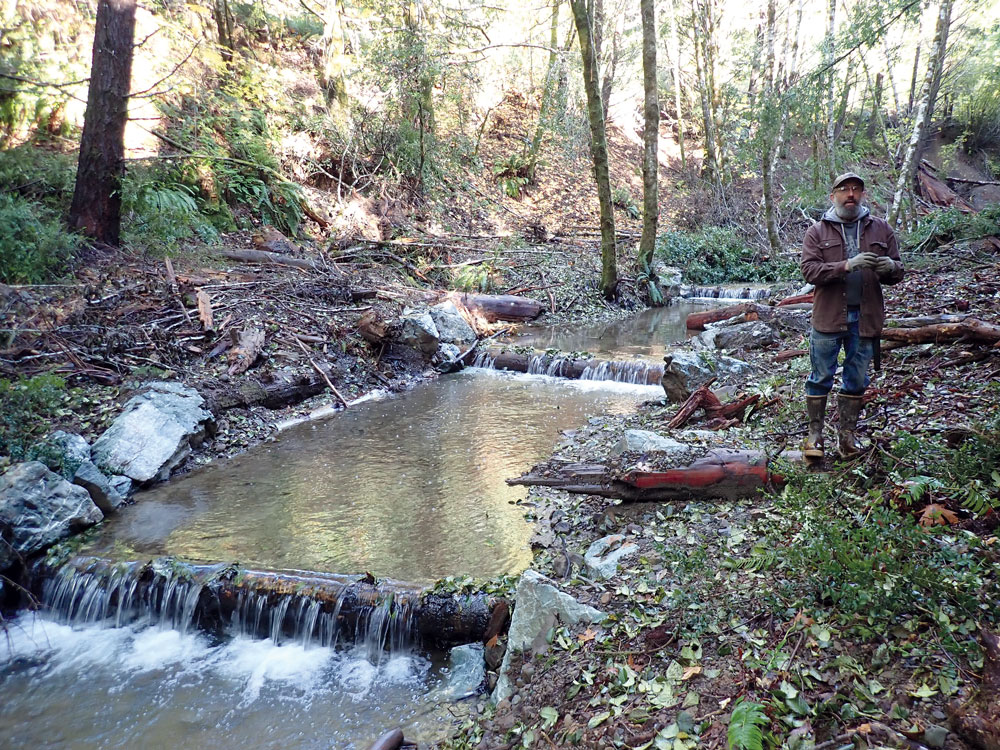Evolving Drought Resilience in McKee Creek
Sanctuary Forest
By Anna Rogers, Tasha McKee, and Ash Brookens
Traveling through the Upper Mattole in southern Humboldt County, you may have noticed some activity between Ettersburg and Whitethorn Junctions over the past two months. Sanctuary Forest, in partnership with the Mattole Salmon Group and Logan Edwards of Edwards Excavation & Restoration, broke ground on a new streamflow and habitat project in McKee Creek in mid-September. Work was underway when the early rains arrived, so the project has been paused until next summer, but there’s much to share about this exciting endeavor!
McKee Creek, a tributary to the Mattole River, was selected for this restoration project because, like many watersheds in our area, it experiences extreme low-flow issues in mid to late summer. Sanctuary Forest has implemented similar pilot projects in various valley settings to learn what strategies are most effective, but realized the need for additional upstream enhancements in order to improve drought resilience. As well, this portion of McKee Creek offered a different valley setting: a colluvial hillslope, or confined valley. Recent work in the Mattole and elsewhere has shown that there is significant potential for water storage in this type of confined valley setting, based on the properties and depth of the weathered bedrock layer present at the toes of hillslopes.

photo by Tasha McKee
This project seeks to restore geomorphic, hydrologic, and ecological processes that will, in turn, address issues of low to no dry-season streamflow, channel incision, disconnected floodplains, lack of off-channel habitat, and an absence of instream wood. This is accomplished by raising the streambed through a series of log and boulder step pools in the mainstem of McKee Creek. The step pools will mimic the natural accumulation of large wood jams and be strategically placed to cause inundation of the inset floodplains during winter flows. This will immediately increase drought resilience by enhancing groundwater recharge and storage, and corresponding instream flow, as well as creating much-needed winter and summer rearing habitat for salmonids. The increased pool depth and area, along with restored channel connectivity to floodplains, also offers refugia to juvenile salmonids during extreme winter storm events.
New restoration strategies are being utilized, including what is referred to as a “modified stage-zero” approach to inundating disconnected floodplains. This is achieved by carefully engineered grading of disconnected floodplains, combined with partial filling of the existing incised channel. The objective is to create a broad floodplain with lots of wood scattered over it such that the creek can flow over the full width of the new floodplain, creating a multi-threaded channel. The stream will carve new channels and pools where it interacts with the wood. This broader, slower, meandering flow will result in increased water storage and improved winter and summer rearing habitat. If you happen to stop and look at the project from Briceland-Thorn Road, you will likely think it looks very messy. However, this “messiness,” with many different sizes of logs and branches strewn everywhere, is critical for this restoration approach. We’re very excited to observe the evolution of this site.
Project managers Tasha McKee (Sanctuary Forest), Cam Thompson (Mattole Salmon Group), and Joel Monschke (Stillwater Sciences) have each reported that they’re very happy with how the project is performing thus far. Even with the abundant rain we recently received (~13 inches through October 25th), the project is handling flows very well and was running clear just a day after the rains subsided. The site will be continually monitored during big rain events this winter to ensure adjustments are made as needed to avoid downcutting and scour. We look forward to updating the community once the project is completed next summer.
We are so thankful for the support of our funders, including the Wildlife Conservation Board for funding the acquisition and conservation of the 300-acre McKee Creek property in 2018, and the Wildlife Conservation Board, the Natural Resources Conservation Service, and the Resource Legacy Fund, who funded implementation of this project. We would also like to thank Green Diamond Resource Company for their donation of some of the logs needed for construction of the log weirs and backwater jams. And finally, we extend our deep appreciation to our project partners, Stillwater Sciences, the Mattole Salmon Group, and Edwards Excavation, without whom this work could not be completed.
For more information: www.sanctuaryforest.org
